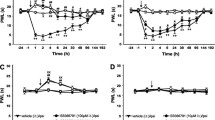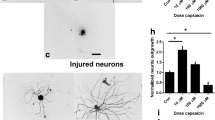Abstract
Pretreatment with the ultrapotent capsaicin analog resiniferatoxin (RTX) has been applied as a selective pharmacological tool in inflammation and pain studies to desensitize transient receptor potential vanilloid 1 (TRPV1) receptor-expressing sensory nerve endings. The discovery of TRPV1 receptor on non-neural cells challenges systemic RTX desensitization as a method acting exclusively on a population of sensory neurons, but not on non-neural cells. Systemic RTX desensitization was used for chemical denervation and transection of the sciatic and saphenous nerves for surgical denervation in rats. Quantitative real-time PCR and immunohistochemistry were applied to investigate the presence and alterations of the TRPV1 receptor mRNA and protein following chemical and surgical denervation. We provided the first evidence for non-neural TRPV1 immunopositivity and mRNA expression in the rat dorsal paw and plantar skin as well as the oral mucosa. Neither chemical nor surgical denervation influenced the level of TRPV1 receptor mRNA and protein expression in non-neural cells of either skin regions or mucosa. Therefore, RTX and consequently capsaicin remain to be considered as selective neurotoxins for a population of primary afferent neurons.




Similar content being viewed by others
References
Alawi K, Keeble J (2009) The paradoxical role of the transient receptor potential vanilloid 1 receptor in inflammation. Pharmacol Ther 125:181–195
Anand P, Bley K (2011) Topical capsaicin for pain management: therapeutic potential and mechanisms of action of the new high-concentration capsaicin 8 % patch. Br J Anaesth 107:490–502
Athanasiou A, Smith PA, Vakilpour S et al (2007) Vanilloid receptor agonists and antagonists are mitochondrial inhibitors: how vanilloids cause non-vanilloid receptor mediated cell death. Biochem Biophys Res Commun 354:50–55
Ban A, Marincsak R, Biro T et al (2010) Up-regulation of transient receptor potential type-1 receptor expression in oral lichen planus. Neuroimmunomodulation 17:103–108
Banvolgyi A, Palinkas L, Berki T et al (2005) Evidence for a novel protective role of the vanilloid TRPV1 receptor in a cutaneous contact allergic dermatitis model. J Neuroimmunol 169:86–96
Birder LA, Kanai AJ, de Groat WC et al (2001) Vanilloid receptor expression suggests a sensory role for urinary bladder epithelial cells. Proc Natl Acad Sci USA 98:13396–401
Bodo E, Biro T, Telek A et al (2005) A hot new twist to hair biology: involvement of vanilloid receptor-1 (VR1/TRPV1) signaling in human hair growth control. Am J Pathol 166:985–998
Calixto JB, Kassuya CAL, Andre E, Ferreira J (2005) Contribution of natural products to the discovery of the transient receptor potential (TRP) channels family and their functions. Pharmacol Ther 106:179–208
Caterina MJ, Schumacher MA, Tominaga M, Rosen TA, Levine JD, Julius D (1997) The capsaicin receptor: a heat activated ion channel in the pain pathway. Nature 389:816–824
Charrua N, Reguenga C, Cordeiro JM et al (2009) Functional transient receptor potential vanilloid 1 is expressed in human urothelial cells. J Urol 182:2944–2950
Denda M, Fuziwara S, Inoue K et al (2001) Immunoreactivity of VR1 on epidermal keratinocyte of human skin. Biochem Biophys Res Commun 285:1250–1252
Denda S, Denda M, Inoue K, Hibino T (2010) Glycolic acid induces keratinocyte proliferation in a skin equivalent model via TRPV1 activation. J Dermatol Sci 57:108–113
Donnerer J, Lembeck F (1982) Analysis of the effects of intravenously injected capsaicin in the rat. Naunyn Schmiedebergs Arch Pharmacol 320:54–57
Dux M, Santha P, Jancso G (2003) Capsaicin-sensitive neurogenic sensory vasodilatation in the dura mater of the rat. J Physiol (Lond) 552:859–867
Engler A, Aeschlimann A, Simmen BR et al (2007) Expression of transient receptor potential vanilloid 1 (TRPV1) in synovial fibroblasts from patients with osteoarthritis and rheumatoid arthritis. Biochem Biophys Res Commun 359:884–888
Gunthorpe MJ, Szallasi A (2008) Peripheral TRPV1 receptors as targets for drug development. Curr Pharm Des 14:32–41
Helyes Z, Elekes K, Sándor K et al (2010) Involvement of preprotachykinin A gene-encoded peptides and the neurokinin 1 receptor in endotoxin-induced murine airway inflammation. Neuropeptides 44:399–406
Inoue K, Koizumi S, Fuziwara S, Denda S, Inoue K, Denda M (2002) Functional vanilloid receptors in cultured normal human epidermal keratinocytes. Biochem Biophys Res Commun 291:124–129
Jancso N, Jancso-Gabor A, Szolcsanyi J (1967) Direct evidence for neurogenic inflammation and its prevention by denervation and by pretreatment with capsaicin. Brit J Pharmacol 31:138–151
Jancso G, Kiraly E, Jancso-Gabor A (1977) Pharmacologically induced selective degeneration of chemosensitive primary sensory neurons. Nature 270:741–743
Kark T, Bagi Z, Lizanecz E et al (2008) Tissue-specific regulation of microvascular diameter: opposite functional roles of neuronal and smooth muscle located vanilloid receptor-1. Mol Pharmacol 73(5):1405–1412
Ko F, Diaz M, Smith P et al (1998) Toxic effects of capsaicin on keratinocytes and fibroblasts. J Burn Care Rehabil 19:409–413
Lai J-P, Douglas SD, Ho W-Z (1998) Human lymphocytes express substance P and its receptor. J Neuroimmunol 86:80–86
Lazzeri M, Vannucchi MG, Zardo C et al (2004) Immunohistochemical evidence of vanilloid receptor 1 in normal human urinary bladder. Eur Urol 46:792–798
Lee H, Caterina MJ (2005) TRPV channels as thermosensory receptors in epithelial cells. Pflüger’s Arch 451:160–167
Lee YM, Kim YK, Kim KH, Park SJ, Kim SJ, Chung JH (2009) A novel role for the TRPV1 channel in UV-induced matrix metalloproteinase (MMP)-1 expression in HaCaT cells. J Cell Physiol 219(3):766–75
Li WH, Lee JM, Kim JY et al (2007) Transient receptor potential vanilloid-1 mediates heat-shock-induced matrix metalloproteinase-1 expression in human epidermal keratinocytes. J Invest Dermatol 127:2328–2335
Lizanecz E, Bagi Z, Pasztor ET et al (2006) Phosphorylation-dependent desensitization by anandamide of vanilloid receptor-1 (TRPV1): function in rat skeletal muscle arterioles and in Chinese hamster ovary cells expressing TRPV1. Mol Pharmacol 69:1015–1023
Maggi CA, Patacchini R, Tramontana M, Amann R, Giuliani S, Santicioli S (1990) Similarities and differences in the action of resiniferatoxin and capsaicin on central and peripheral endings of primary sensory neurons. Neuroscience 37(53):1–539
Ohtori S, Chiba T, Takahashi K (2000) Neonatal capsaicin treatment decreased substance P receptor immunoreactivity in lamina III neurons of the dorsal horn. Neurosci Res 38:147–154
Pecze L, Szabo K, Szell M et al (2008) Human keratinocytes are vanilloid resistant. PLoS One 3(10):e3419
Pinter E, Szolcsanyi J (1995) Plasma extravasation in the skin and pelvic organs evoked by antidromic stimulation of the lumbosacral dorsal roots of the rat. Neuroscience 68:603–614
Porszasz R, Porkolab A, Ferencz A, Pataki T, Szilvassy Z, Szolcsanyi J (2002) Capsaicin-induced nonneural vasoconstriction in canine mesenteric arteries. Eur J Pharmacol 441:173–175
Radtke C, Sinis N, Sauter M et al (2011) TRPV channel expression in human skin and possible role in thermally induced cell death. J Burn Care Res 32(1):150–9
Saunders C, Kunde DA, Crawford A, Geraghty DP (2007) Expression of transient receptor potential vanilloid 1 (TRPV1) and 2 (TRPV2) in human peripheral blood. Mol Immunol 44:1429–1435
Saunders C, Fassett RG, Geraghty DP (2009) Up-regulation of TRPV1 in mononuclear cells of end-stage kidney disease patients increases susceptibility to N-arachidonoyl-dopamine (NADA)-induced cell death. Biochim Biophys Acta 1792:1019–1026
Seki N, Shirasaki H, Kikuchi M, Sakamoto T, Watanabe N, Himi T (2006) Expression and localization of TRPV1 in human nasal mucosa. Rhinology 44(2):128–34
Southall MD, Li T, Gharibova LS, Pei Y, Nicol GD, Travers JB (2003) Activation of epidermal vanilloid receptor-1 induces release of proinflammatory mediators in human keratinocytes. J Pharmacol Exp Ther 304:217–222
Stander S, Moormann C, Schumacher M (2004) Expression of vanilloid receptor subtype 1 in cutaneous sensory nerve fibers, mast cells, and epithelial cells of appendage structures. Exp Dermatol 13(3):129–139
Starowicz K, Nigam S, Di Marz V (2007) Biochemistry and pharmacology of endovanilloids. Pharmacol Ther 114:13–33
Sugimoto T, Xiao C, Ichikawa H (1998) Neonatal primary neuronal death induced by capsaicin and axotomy involves an apoptotic mechanism. Brain Res 807:147–154
Szallasi A (1995) Autoradiographic visualization and pharmacological characterization of vanilloid (capsaicin) receptors in several species, including man. Acta Physiol Scand 155(Suppl 629):1–68
Szallasi A, Blumberg PM (1999) Vanilloid (capsaicin) receptors and mechanisms. Pharmacol Rev 51:159–211
Szallasi A, Farkas-Szallasi T, Tucker JB et al (1999) Effects of systemic resiniferatoxin treatment on substance P mRNA in rat dorsal root ganglia and substance P receptor mRNA in the spinal dorsal horn. Brain Res 815:177–184
Szallasi A, Cortright DN, Blum CA, Eid SR (2007) The vanilloid receptor TRPV1: 10 years from channel cloning to antagonist proof-of-concept. Nat Rev Drug Discov 6:357
Szolcsanyi J (2004) Forty years in capsaicin research for sensory pharmacology and physiology. Neuropeptides 38:377–384
Szolcsanyi J, Oroszi G, Nemeth J, Szilvassy Z, Blasig IE, Tosaki A (2001) Functional and biochemical evidence for capsaicin-induced neural endothelin release in isolated working rat heart. Eur J Pharmacol 419:215–221
Vyklicky L, Novakova-Tousova K, Benedikt J, Samad A, Touska F, Vlachova V (2008) Calcium-dependent desensitization of vanilloid receptor TRPV1: a mechanism possibly involved in analgesia induced by topical application of capsaicin. Physiol Res 57(suppl 3):S59–S68
Acknowledgements
This work was sponsored by Hungarian Grants OTKA K81984, K73044, and NK78059 and Developing Competitiveness of Universities in the South Transdanubian Region (SROP-4.2.1.B-10/2/KONV-2010-0002).
Author information
Authors and Affiliations
Corresponding author
Rights and permissions
About this article
Cite this article
Kun, J., Helyes, Z., Perkecz, A. et al. Effect of Surgical and Chemical Sensory Denervation on Non-neural Expression of the Transient Receptor Potential Vanilloid 1 (TRPV1) Receptors in the Rat. J Mol Neurosci 48, 795–803 (2012). https://doi.org/10.1007/s12031-012-9766-9
Received:
Accepted:
Published:
Issue Date:
DOI: https://doi.org/10.1007/s12031-012-9766-9




